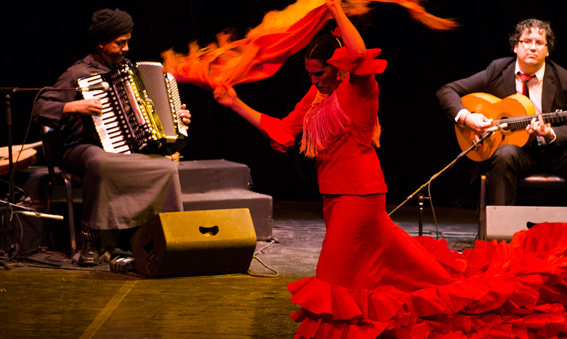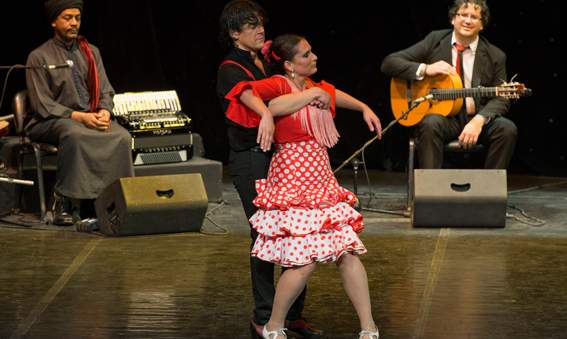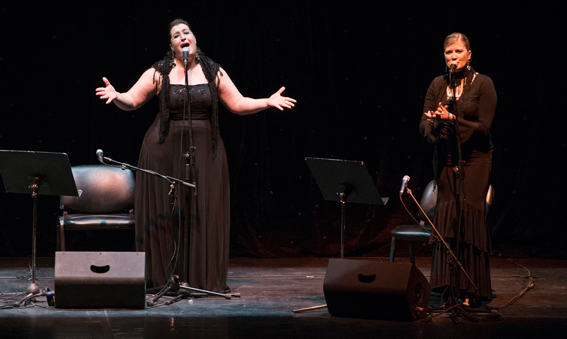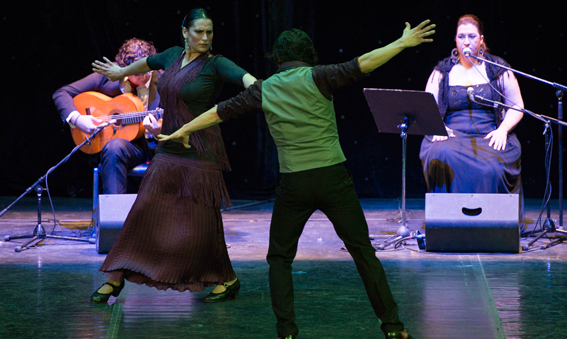The Spanish embassy brings an attraction to the Cairo Opera House, a performance orchestrated by José Barrios called Flamenco Algarabía, which opened here in Cairo with two female singers, a guitarist and Sudanese Wafir S. Gibril on oud.
Early on, it seemed this was going to be a different performance. Notably, it was very lighthearted from the beginning, instead of overly seriously. Also, rather than simply the tablao arrangement ( dance numbers not connected in an overall theme, set in Andalusian bars) they made use of the fact that they were on a full stage. Barrios had been to Cairo twice with María Pagés Flamenco troupe years ago and he says performing his own creation at the Cairo Opera House was one of his dreams. “We’re at the Cairo Opera House!” Barrios tells Ahram Online with a smile.
Not to mention that Gibril seemed intrinsically integrated into the complex music, whether playing the req, accordion or anything else, which revealed after just one or two songs that he was intimately connected to Flamenco.

Photos: Bassam Al-Zoghby
Although the oud is often part of fusion performances, in their opening song Gibril easily played the instrument not with the normal oud harmonies but rather with flamenco harmonies - and on a songtype called bulerías that Flamenco performers count in 6’s no less. The musicians then break into something in the upbeat alegrías family style, then fandangos - and always Gibril is completely integrated.
In fact, when interviewing Gibril and Barrios, Ahram Online discovers that including Gibril and the oud in general wasn’t an afterthought, as in many fusion attempts, but was one of the reasons this particular concert came to be. It turns out Gibril emigrated to Spain in 1990 from Sudan and lives in Madrid but collaborates mostly with Andalusians (from southern Spain – the heart of Flamenco). Like anyone entering the music scene in a new country, he found it difficult. It was particularly difficult in Spain, he reasons, both because he didn’t do as many immigrants do, which is go to a country where there are already many of their compatriots and also because Mediterranean countries are very settled and set in their customs, whereas other countries may be more welcome to newcomers. Music, however, he says “doesn’t go by geographic limitations.”
With more than 20 years of experience and an inquisitive, thoughtful mind, Gibril is what Barrios called “versatile.” The apt musician plays medieval Andalusian music on a regular basis and has been to Cairo before and visits Sudan once or twice a year but has amassed a considerable amount of world music experience. Gibril was a cornerstone for Algarabía performances: “he can just as easily play something Lebanese as an Argentine Tango,” Barrios says.
On the idea of fusion, Gibril clarifies to Ahram Online in perfect Spanish that he doesn’t feel he plays “fusion,” because he plays what a Sudanese normally plays: he’s not changing or forcing anything, but rather simply adapting or adjusting. For instance, he says, in a particular section right after the bulería de Cádiz, deep into Algarabía performance, he plays a Sudanese-inspired song that he composed and follows the alegrías cadence. He and singer María Jose also enjoyed each other’s sound as Gibril held a note on his accordion together with the singer. The note held a magical smile-through-tears mix of both the sound of Flamenco and North Africa.
The instruments nor the harmonies are similar, though, in North African and Spanish music, but what they do have in common, he feels, are some of the beats. In a golden nugget of insight for any musician, he reveals that the Flamenco bulerías is similar to a rhythm called mardoum and the tanquillos to the tum tum.
Gibril also played with the famous world music band Radio Tarifa, a huge band that mixed every Middle Eastern/North African instrument possible. He recounts that at first there were only four members: the singer, guitarist, percussionist and Wafir. Even after the band split up, Wafir was working with the singer, Benjamín Escoriza, on his solo project when he died in March 2012 before completion.
Working with Radio Tarifa and singer Escoriza was among his most proudest projects. The current show, Algarabía, was Gibril’s first answer when asked what he was proud of. It opened in 2011 in Guatemala on the day of Hispanic culture and then went on a wildly successful tour in the US.
Commenting on the relaxed, positive energy onstage, Gibril says that although music can sometimes be riddled with negative things, such as drugs and competitiveness, he says that this troupe is like a family, where the members are comfortable with each other and disciplined.
The show's concept, although grounded in sad life milestones, is dealt with lightly, so Ahram Online asks the head of the project, Barrios: “Where did your sense of humour come from?”
Barrios immediately laughs and says “We were seven brothers and sisters growing up. We had to take things lightly!”

Photos: Bassam Al-Zoghby
It was delightful to watch dancer Ana González, who from the beginning enjoyed her role as a “doll” that Barrios would set in poses and dance with as a “child.” Slowly the couple takes the audience from childhood to something a little more mature and finally into a seguiriyas - a song hammered out to a resounding, paused rhythm that speeds up abruptly at times, only to be brought down again to a march as solemn as the seguiriyas topic: death.

Photos: Bassam Al-Zoghby
The two female voices are quite different: Gema Caballero is very Flamenco and expertly accustomed to playing in and out of the beat. The other, María Jose Jimenez is strong and coplera (in the tradition of popular songs), and the women know how and when to blend and compliment each other as if you were listening to your favourite Flamenco CD.
But this isn’t the end. They continue giving to the audience, playing a flamenco-fied version of Bint Shalabiyya.
Barrios also takes a moment to give 110 percent to his audience with a solo; a sort of Flamenco and modern-dance version of a euphoric “Singing in the Rain,” complete with trench coat. I could feel in the Egyptian audience the lack of comprehension behind Barrios’ costume. Underneath his fitted-to-the-waist coat, which flowed openly at the bottom to create nice onstage effects, he wore a red shirt cut vertically so it would appear to be stripes. The song says in Spanish something to the effect of “and the result was red lines marked on my chest.”
The performers brought in a bit of audience participation with a famous social folkloric dance called sevillanas and prompted the audience to yell a loud "whei!" on cue.

Photos: Bassam Al-Zoghby
Algarabía was a much lighter show than most Flamenco performances, but that in no way whatsoever reduces the professionalism, concept, or even disregards serious topics. The performers take a light approach to serious topics and moves the audience happily with them throughout life stages.
Programme:
7 March, 8:00pm
Cairo Opera House
8 March, 8:00pm
Alexandria Opera House (Sayed Darwish Theatre)
Short link: